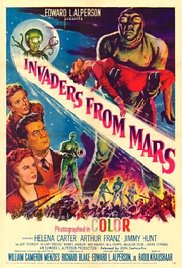Previous FilmInseminoid
Next FilmInvasion from Inner Earth
Invaders From Mars 1953
 | A young boy learns that space aliens are taking over the minds of earthlings. |
The Cast
| Helena Carter | - | Dr. Pat Blake |
| Arthur Franz | - | Dr. Stuart Kelston |
| Jimmy Hunt | - | David MacLean |
| Leif Erickson | - | Mr. George MacLean |
| Hillary Brooke | - | Mrs. Mary MacLean |
| Morris Ankrum | - | Col. Fielding |
| Max Wagner | - | Sgt. Rinaldi |
| William Phipps | - | Sgt. Baker |
Film Trivia
Luce Potter, one of the Munchkins in The Wizard of Oz (1939), played the Martian "head" enclosed in glass in the film. For years she received letters from fans of the movie telling her how much she had scared them as kids.
The special effects department used condoms to create the "bubbles" on the walls of the underground tunnels.
The eerie sandpit choir chant was done by a choral group made up of eight men and eight women. Moreover, said chant was further enhanced with echo in post-production to give it a more haunting and ethereal quality.
The sandpit opening and closing was done by cutting a long slit in a piece of heavy canvas and inserting a large funnel. A hose from a powerful vacuum was attached to the funnel and the whole thing was then covered with sand. The vacuum was activated and the sand was sucked down for the shots of the sandpit opening. Moreover, the film was simply reversed for shots of the sandpit closing.
In one scene, Dr. Kelston refers to the "Lubbock Lights" and to a "Captain Mantell." These were real life U.F.O. events that created a national wide sensation in their day. The photographs shown by Dr Kelston are actual photographs of the Lubbock Lights that appeared in newspapers and magazines.
This was actually one of the first science-fiction scripts written in the 1950s. The revised version of the script was completed in September 1950. The film wasn't produced until 1952 and released in early 1953.
In August 1957 this film was being shown on a double bill with This Island Earth (1955).
This film was shot on the new single-strip EastmanColor negative. Cinecolor Labs then produced the trailers and release prints in the three-color Cinecolor process. When Cinecolor went bankrupt, the original elements and printing matrices were seized and sold for salvage.
Little people were chosen to double the main characters when an action shot by one of the mutants was required. Six mutants ranging in size from 5'1" to 6'3" acted in these shots with the little people to keep the size ratio correct. This was necessary because the primary Mutants were 8'2" and 7'7" and rather ungainly in their movements due to costuming restrictions.
Among the cost-cutting measures made during filming was the elimination of Cricket, David's dog. The use of animals during filming almost always takes more time, and therefore more money, a luxury that director William Cameron Menzies didn't have.
According to script supervisor Mary Yerke, director and production designer William Cameron Menzies filled 12 notebooks with charcoal sketches depicting every scene he planned to shoot. Just days before principal photography, all of these storyboard sketches disappeared from the production office.
The tune playing as shots of tanks and trucks of infantry leave to attack the invaders is the official song of the U.S. Army ("The Army Goes Rolling Along"). This is based on the song "U.S. Field Artillery March" (also known as "The Caisson Song") by Edmund L. Gruber and John Philip Sousa (1917). It was adopted by the U.S. Army as its official song in 1956.
Film debut of Richard Deacon.
Controversy and dispute surrounds the history of the movie. According to recent interviews, John F. Seitz, the cinematographer, confirmed that the film was planned in great detail to be filmed in 3D but that the last minute it was discovered that no camera was available. Nonetheless, it is claimed that all of the sets were constructed at Republic Studios to be shot in 3D and that the artificial separation of set elements is confirmation of this design intention. Meanwhile, the only documentary evidence for a 3D production is a claimed newspaper advertisement placed by the producers (not the studio) while the film was in pre-production, and no official records are known to exist to throw further light onto the matter.
The stock footage showing tanks being loaded onto train flatcars and driven before the camera were actually WW2 M10 tank destroyers and by the time of this movie were superseded during and after the war by newer models. You can tell them from actual tanks by the huge bolts on the hull (body) and turrets. Battle tanks are welded together with smooth bodies as also seen in the movie.
Several well-known actors appear with very small parts. Among them are: Todd Karns playing Jimmy the gas station attendant who was also in 1946 It's a Wonderful Life as Harry Bailey; Lock Martin was the martian mutant carrying little David in the underground tunnel, and was also in 1951 The Day the Earth Stood Still as the giant robot Gort; Millburn Stone who was searching the sand area with a detector to locate the underground martians, was also in Gunsmoke for many years as Doc Adams; and Barbara Billingsley playing Kelston's secretary also played Mrs. Cleaver as Beaver's mother in Leave it to Beaver.
The screenplay was originally optioned by Arthur Gardner and Jules V. Levy. The option expired before they could get a production off the ground. The rights then went to Levy's boss, producer Edward L. Alperson.